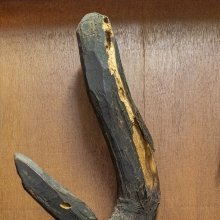Manca, Mañca, Mamca, Mamca, Māñcā: 21 definitions
Introduction:
Manca means something in Buddhism, Pali, Hinduism, Sanskrit, the history of ancient India, Jainism, Prakrit, Hindi, biology, Tamil. If you want to know the exact meaning, history, etymology or English translation of this term then check out the descriptions on this page. Add your comment or reference to a book if you want to contribute to this summary article.
Manca has 20 English definitions available.
Alternative spellings of this word include Mancha.
Images (photo gallery)
Languages of India and abroad
Sanskrit dictionary
[Deutsch Wörterbuch]
Source: Cologne Digital Sanskrit Dictionaries: Böhtlingk and Roth Grosses Petersburger WörterbuchMañca (मञ्च):—m.
1) Schaugerüste: mañcāṃśca kārayāmāsustatra jānapadā janāḥ . vipulānucchrayopetān [Mahābhārata 1, 5323.] āruruhurmañcānmeruṃ devastriyo yathā [5327.] upopaviṣṭā mañceṣu draṣṭukāmāḥ svayaṃvaram [6959.] [Harivaṃśa 4527.] vāṭāḥ [4528. 4533.] mañcāgāraiḥ [4645.] mañcārohaṇa [4530. 4646.] mañcānniṣkramya [4768. 9114.] mañcayūpocchrayaistaistu sarvataḥ samalaṃkṛtaḥ . rarāja subhṛśaṃ yajñaḥ kalpavṛkṣairivocchritaiḥ .. [Rāmāyaṇa Gorresio 1, 13, 27.] sa tatra mañceṣu manojñaveṣāṃsiṃhāsanasthānupacāravatsu apaśyat naralokapālān [Raghuvaṃśa 6, 1.] kḷptena sopānapathena mañcam -āruroha 3. mañcāntararājamārga [10.] sthaṃ madhusūdanam [PAÑCAR. 2, 7, 15.] mañcānnipātitam [3, 14, 67.] = karṇavaṃśa Plattform auf einem Palaste [Hārāvalī 132.] Vgl. [WILSON] in [Viṣṇupurāṇa S. 552. fgg.] —
2) Ruhebett [Amarakoṣa 2, 6, 3, 39.] [Hemacandra’s Abhidhānacintāmaṇi 683.] [Scholiast] zu [Raghuvaṃśa ed. Calc. 6, 1.] [Ānandalaharī 8] in [Kāvya-Saṅgraha 247.] Sitz, Thron [Vyutpatti oder Mahāvyutpatti 194.]
--- OR ---
Mañca (मञ्च):—
2) [Kathāsaritsāgara 93, 49.]
Source: Cologne Digital Sanskrit Dictionaries: Sanskrit-Wörterbuch in kürzerer FassungMañca (मञ्च):—n. —
1) Schaugerüste , Plattform auf einem Palaste. mañcāḥ (so v.a. mañcasthāḥ) krośanti Comm. zu [Prātiśākhya] —
2) Ruhebett. —
3) Gestell [Baudh] im Comm. zu [Taittirīyāraṇyaka 1,22,9.] —
4) ein best. Tact S. S. S 210. 252.
Sanskrit, also spelled संस्कृतम् (saṃskṛtam), is an ancient language of India commonly seen as the grandmother of the Indo-European language family (even English!). Closely allied with Prakrit and Pali, Sanskrit is more exhaustive in both grammar and terms and has the most extensive collection of literature in the world, greatly surpassing its sister-languages Greek and Latin.
See also (Relevant definitions)
Starts with (+138): Mamcadakalahullu, Mamcadakaluhullu, Mamcal, Mamcalpidi, Mamcalu, Mamcalvidi, Mamcapatri, Mamcatike, Manca nanatti, Manca-kuli-panpanam, Manca-tannirkaraittal, Mancabandha, Mancabhadra, Mancadayaka, Mancadera, Mancagara, Mancainirpputtiran, Mancaka, Mancakagata, Mancakamancaka.
Ends with (+19): Capparamamca, Citramanca, Giligilimamca, Gilukemamca, Gujjarimamca, Halagemamca, Hasumamca, Hodemamca, Jaganamanca, Kamamca, Karilamamca, Kolumamca, Kurcimamca, Lamamca, Lomanca, Madhumamca, Mahamanca, Mancatimanca, Maranamanca, Masaraka-manca.
Full-text (+61): Mancaka, Mancamandapa, Manch, Mancapitha, Pratimanca, Vyaakhyaan-manch, Saarvajanik-bhaashan-manch, Mancanritya, Manci, Manja, Sabha, Manca nanatti, Masaraka, Mancam, Manja pumeram, Manja punna, Manja-kurini, Manja-adeca-manjen, Manja kadambai, Manja-kua.
Relevant text
Search found 22 books and stories containing Manca, Mañca, Mamca, Mamca, Māñcā, Maṃca, Maṃca, Mañcā, Mancha, Manchaa, Manch, Manja, Maanchaa; (plurals include: Mancas, Mañcas, Mamcas, Māñcās, Maṃcas, Mañcās, Manchas, Manchaas, Manches, Manjas, Maanchaas). You can also click to the full overview containing English textual excerpts. Below are direct links for the most relevant articles:
Garga Samhita (English) (by Danavir Goswami)
Verse 5.8.28 < [Chapter 8 - The Killing of Kaṃsa]
Verse 5.8.21 < [Chapter 8 - The Killing of Kaṃsa]
Verse 5.7.38 < [Chapter 7 - The Killing of Kuvalayāpīḍa]
Vakyapadiya of Bhartrihari (by K. A. Subramania Iyer)
Verse 3.14.347 < [Book 3 - Pada-kāṇḍa (14): Vṛtti-samuddeśa (On Ccomplex Formation)]
Verse 3.14.150 < [Book 3 - Pada-kāṇḍa (14): Vṛtti-samuddeśa (On Ccomplex Formation)]
Verse 3.14.152 < [Book 3 - Pada-kāṇḍa (14): Vṛtti-samuddeśa (On Ccomplex Formation)]
The Matsya Purana (critical study) (by Kushal Kalita)
Part 1a - Note on Architecture (vāstu) < [Chapter 7 - Art and Architecture in the Matsyapurāṇa]
Vinaya (3): The Cullavagga (by T. W. Rhys Davids)
Cullavagga, Khandaka 6, Chapter 2 < [Khandaka 6 - On Dwellings and Furniture]
Cullavagga, Khandaka 6, Chapter 19 < [Khandaka 6 - On Dwellings and Furniture]
Cullavagga, Khandaka 8, Chapter 1 < [Khandaka 8 - Regulations as to the Duties of the Bhikkhus towards one Another]
Sahitya-kaumudi by Baladeva Vidyabhushana (by Gaurapada Dāsa)
Text 2.12 < [Chapter 2 - The Natures of Words (śabda)]
Text 2.15 < [Chapter 2 - The Natures of Words (śabda)]
Text 2.13 < [Chapter 2 - The Natures of Words (śabda)]
Manasara (English translation) (by Prasanna Kumar Acharya)
Related products

